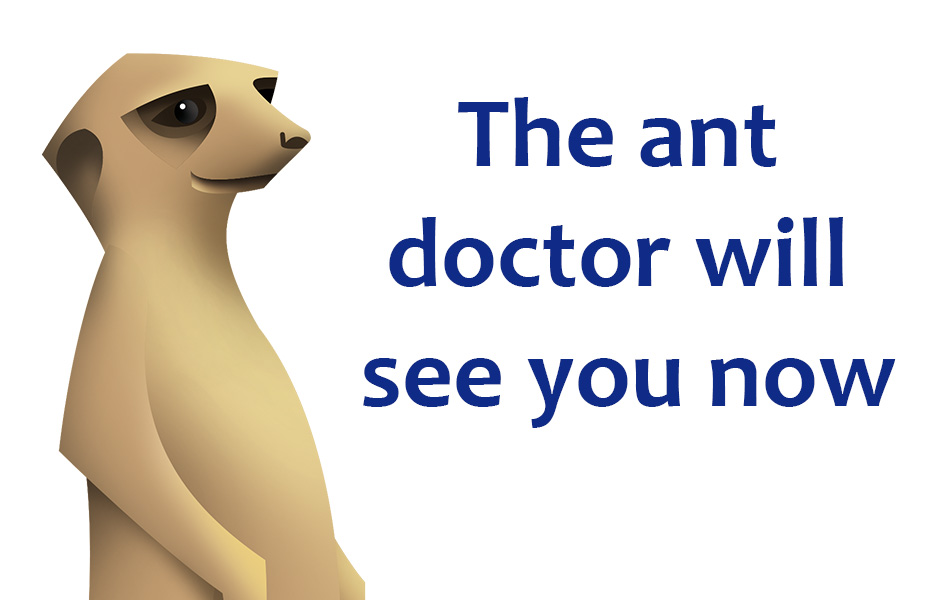I’ve spent more time than most observing ants, and I’ve come to find them ‘cute’ – something few other people understand, and that is often hard to convey. So it’s nice to find a paper that offers the opportunity to give people a glimpse into the cuteness I see in ant behaviour.
Ants clean the wounds of injured nest mates, often saving their lives and keeping infection out of the colony.
To see how the colony deals with those injured in battle, Frank and colleagues removed varying numbers of limbs (two or five) from healthy ants as they left their nest in Comoe´ National Park (Coˆte d’Ivoire). The rest of the raiding party was left to do it’s thing, and after the raid was finished, the injured ants were placed by the side of the returning trail of ants. They found that injured ants attracted attention from returning raiders, and those with relatively minor injuries (two lost legs) were carried back to the nest in about half of the trials.
When inspected by a fellow ant, these ants would crouch down into a position that made them easy to carry. But seriously injured ants (missing 5 legs) refused to be carried back, squirming and flailing their remaining limb, and preventing their nest mates from picking them up. The authors suggest this may be a self-selecting process to decide which ants are potentially treatable and which are mortally wounded – if an injured ant has enough remaining legs to balance and crouch into position, then it will be carried back to the nest and treated, otherwise it will be too difficult to carry (and probably too badly injured to be saved) and be left behind by its nest mates*.
Interestingly, the ants that were injured would deliberately walk more slowly while the return party was passing by, even though the experimenters found that they were capable of running faster if they needed to. Although it’s tempting to read this as the ants putting it on so they get help from their nest mates, it’s more likely that moving slowly makes it more likely they will be noticed, and it’s better for the colony as a whole to return them quickly for treatment.
* The world of ants is still brutal – sadly there is no palliative care in social insects.
Once inside the nest, injured ants were groomed extensively by their nest mates, whose grooming focussed on the open wound – presumably helping to remove dirt, and maybe even apply microbial substances. Many species of ant are known to produce antimicrobial secretions from a gland called the metapleural gland, which lies between the abdomen and thorax. When they groom themselves, they spread this over their bodies, helping to prevent infection. Leaf-cutter ants, too, treat their underground fungus farm with antibiotics to prevent devastating crop losses. So although it wasn’t tested in this study, it’s plausible that cleaning the wound involves treating it with substances that kill bacteria and prevent infection. In support of this idea, the team found that in the lab, injured ants that had been groomed by nest mates before being isolated in a tube with some soil had an 80% chance of survival, compared to just 10% for ants that did not receive any grooming before being placed in the soily tube.
There are many other examples of how ants have developed what is sometimes called ‘social immunity’. Ants carry waste material out of the nest to reduce the chances of disease. In many species, ants that are infected with a deadly disease, or mortally injured, will leave the nest to avoid infecting the rest of the colony. It seems only logical that for relatively minor injuries or infections, ants should try to treat the ailment and save the individual ant. Although each ant in a colony is relatively ‘cheap’ to produce (it’s often better to think of them like cells in a body than individuals), they aren’t worth nothing, and especially in species with smaller colonies (hundreds or thousands rather than hundreds of thousands) it can be worth the effort to save an injured ant.
One of the biggest problems humans encountered when they first began living in cities was disease – suddenly, diseases that had caused few problems for human communities at low population densities were spreading through the first cities like wildfire. Close proximity was making transmission too easy. Over time, we came up with ways to deal with it – most importantly a sewer system and sanitation. Over the last few decades, research has shown that ants are no different.
Want to know more?
- Frank, E. T., Wehrhahn, M., & Linsenmair, K. E. (2018, February). Wound treatment and selective help in a termite-hunting ant. In Proc. R. Soc. B (Vol. 285, No. 1872, p. 20172457). The Royal Society.
- The life-saving care provided by ant medics. Nature Research Highlights
- Evans, J. D., & Spivak, M. (2010). Socialized medicine: individual and communal disease barriers in honey bees. Journal of invertebrate pathology, 103, S62-S72.
- Fernández-Marín, H., Zimmerman, J. K., Rehner, S. A., & Wcislo, W. T. (2006). Active use of the metapleural glands by ants in controlling fungal infection. Proceedings of the Royal Society of London B: Biological Sciences, 273(1594), 1689-1695.
- Beattie, A. J., Turnbull, C. L., Hough, T., & Knox, R. B. (1986). Antibiotic production: a possible function for the metapleural glands of ants (Hymenoptera: Formicidae). Annals of the Entomological Society of America, 79(3), 448-450.





